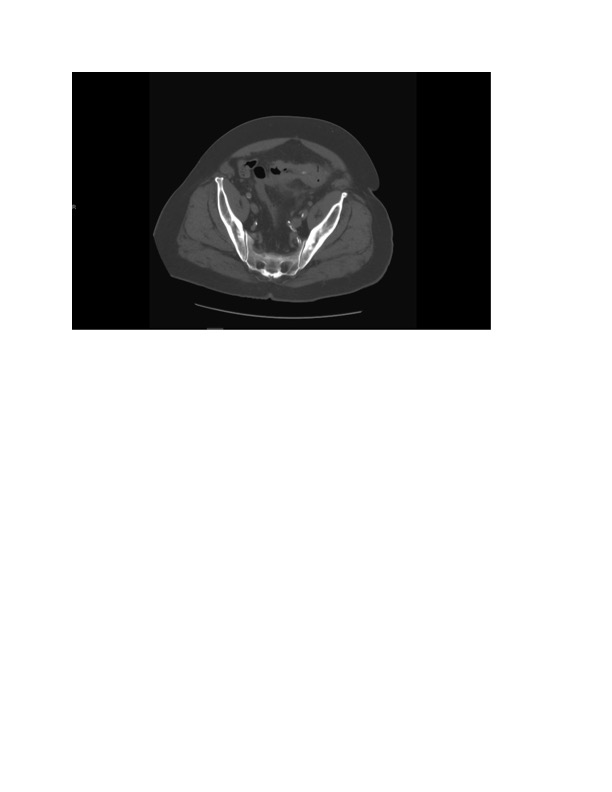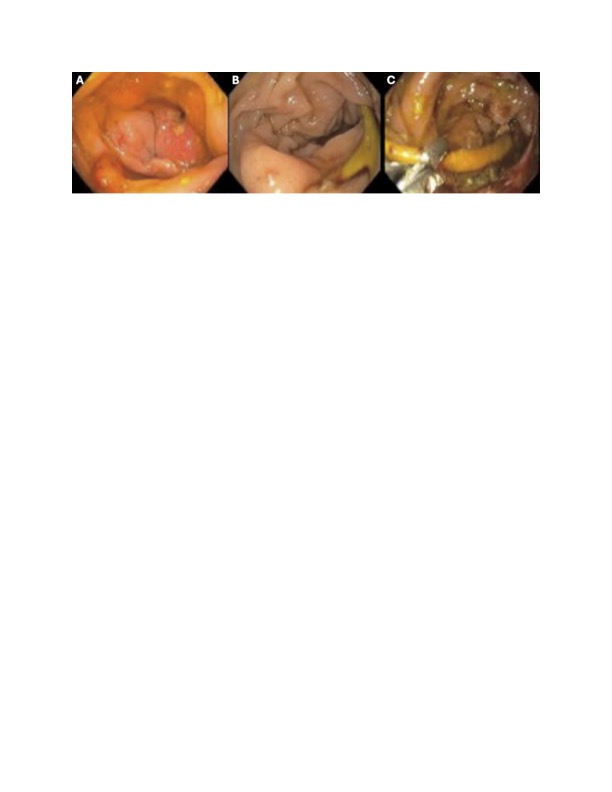Tuesday Poster Session
Category: General Endoscopy
P5163 - Make a Wish: Wishbone Ingestion Leading to a Diagnosis of Occult Malignancy
Tuesday, October 28, 2025
10:30 AM - 4:00 PM PDT
Location: Exhibit Hall

Natalie Rosseau, MD (she/her/hers)
University of Florida Health Shands Hospital
Gainesville, FL
Presenting Author(s)
Natalie Rosseau, MD1, Hannah Zuercher, MD1, Ahmed Al Qady, MD2, Anand Gupte, MD, MS1, John Lieb, MD1
1University of Florida Health Shands Hospital, Gainesville, FL; 2University of Florida, Gainesville, FL
Introduction: Foreign body ingestion can lead to life-threatening complications, including colonic perforation, especially with sharp-pointed objects. We detail an unusual case of a foreign body ingestion, a wishbone, leading to a diagnosis of sigmoid adenocarcinoma.
Case Description/
Methods: A male in his seventies with PMHx DM and CAD presented with a 2 week history of LLQ abdominal pain and diarrhea. He was afebrile and hemodynamically stable. He had never received a colonoscopy.
Initial laboratory analysis showed hemoglobin of 12.7 g/dL (normal: 13.9-18.0 g/dL) and white blood cell count of 9 x10E3 k/cm (normal: 4.6-10.8 k/cm). Computed tomography (CT) of the abdomen and pelvis with contrast noted circumferential mural thickening of the sigmoid colon with a wishbone impacted at the proximal thickened bowel segment. Given the atypical foreign body impaction location, colonic malignancy was suspected. Colonoscopy demonstrated a sigmoid colonic friable, partially-obstructing circumferential mass measuring 4-5 cm in length, causing luminal narrowing. Proximal to the mass was an impacted wishbone. Endoscopic attempts to remove the wishbone were unsuccessful due to its Y-shape abutting the colonic mass. Carcinoembryonic antigen level was 14.1 ng/mL (normal: 0-5 ng/mL). Given that the patient continued to have bowel movements and that there was no hemodynamic compromise or evidence of perforation, the surgical team recommended outpatient removal. The patient was discharged with follow-up.
He re-presented two weeks later with worsening abdominal pain and distension, fever, and focal peritoneal signs. CT abdomen and pelvis redemonstrated wishbone impaction, with adjacent free air concerning for sigmoid perforation. He underwent exploratory laparotomy with wishbone removal, sigmoid colectomy, and diverting loop ileostomy. Pathology noted a 5.7 centimeter, moderately differentiated sigmoid colon stage T3N0 adenocarcinoma, with the margins free of tumor. He was discharged to a skilled nursing facility for post-operative recovery with vacuum-assisted midline incision therapy.
Discussion: We present the case of an ingested foreign body, a wishbone, causing a presenting symptom of abdominal pain without initial colonic perforation. Endoscopic attempts to remove the wishbone were unsuccessful due to an obstructing neoplastic mass, eventually leading to a colonic perforation prior to elective surgical intervention. These unforeseen findings highlight the intricacies and challenges of managing foreign body ingestion.

Figure: Figure 1. Ingested wishbone visualized radiographically at the level of sigmoid colon with proximal thickened bowel segment.

Figure: Figure 2, Parts A, B, and C:
Part A. Endoscopic image of 4-5cm friable, partially-obstructing circumferential mass in the sigmoid colon, causing luminal narrowing.
Part B. Endoscopic image of ingested wishbone impacted proximal to the stricture.
Part C. Endoscopic image of attempted wishbone removal using retrieval forceps.
Disclosures:
Natalie Rosseau indicated no relevant financial relationships.
Hannah Zuercher indicated no relevant financial relationships.
Ahmed Al Qady indicated no relevant financial relationships.
Anand Gupte indicated no relevant financial relationships.
John Lieb indicated no relevant financial relationships.
Natalie Rosseau, MD1, Hannah Zuercher, MD1, Ahmed Al Qady, MD2, Anand Gupte, MD, MS1, John Lieb, MD1. P5163 - Make a Wish: Wishbone Ingestion Leading to a Diagnosis of Occult Malignancy, ACG 2025 Annual Scientific Meeting Abstracts. Phoenix, AZ: American College of Gastroenterology.
1University of Florida Health Shands Hospital, Gainesville, FL; 2University of Florida, Gainesville, FL
Introduction: Foreign body ingestion can lead to life-threatening complications, including colonic perforation, especially with sharp-pointed objects. We detail an unusual case of a foreign body ingestion, a wishbone, leading to a diagnosis of sigmoid adenocarcinoma.
Case Description/
Methods: A male in his seventies with PMHx DM and CAD presented with a 2 week history of LLQ abdominal pain and diarrhea. He was afebrile and hemodynamically stable. He had never received a colonoscopy.
Initial laboratory analysis showed hemoglobin of 12.7 g/dL (normal: 13.9-18.0 g/dL) and white blood cell count of 9 x10E3 k/cm (normal: 4.6-10.8 k/cm). Computed tomography (CT) of the abdomen and pelvis with contrast noted circumferential mural thickening of the sigmoid colon with a wishbone impacted at the proximal thickened bowel segment. Given the atypical foreign body impaction location, colonic malignancy was suspected. Colonoscopy demonstrated a sigmoid colonic friable, partially-obstructing circumferential mass measuring 4-5 cm in length, causing luminal narrowing. Proximal to the mass was an impacted wishbone. Endoscopic attempts to remove the wishbone were unsuccessful due to its Y-shape abutting the colonic mass. Carcinoembryonic antigen level was 14.1 ng/mL (normal: 0-5 ng/mL). Given that the patient continued to have bowel movements and that there was no hemodynamic compromise or evidence of perforation, the surgical team recommended outpatient removal. The patient was discharged with follow-up.
He re-presented two weeks later with worsening abdominal pain and distension, fever, and focal peritoneal signs. CT abdomen and pelvis redemonstrated wishbone impaction, with adjacent free air concerning for sigmoid perforation. He underwent exploratory laparotomy with wishbone removal, sigmoid colectomy, and diverting loop ileostomy. Pathology noted a 5.7 centimeter, moderately differentiated sigmoid colon stage T3N0 adenocarcinoma, with the margins free of tumor. He was discharged to a skilled nursing facility for post-operative recovery with vacuum-assisted midline incision therapy.
Discussion: We present the case of an ingested foreign body, a wishbone, causing a presenting symptom of abdominal pain without initial colonic perforation. Endoscopic attempts to remove the wishbone were unsuccessful due to an obstructing neoplastic mass, eventually leading to a colonic perforation prior to elective surgical intervention. These unforeseen findings highlight the intricacies and challenges of managing foreign body ingestion.

Figure: Figure 1. Ingested wishbone visualized radiographically at the level of sigmoid colon with proximal thickened bowel segment.

Figure: Figure 2, Parts A, B, and C:
Part A. Endoscopic image of 4-5cm friable, partially-obstructing circumferential mass in the sigmoid colon, causing luminal narrowing.
Part B. Endoscopic image of ingested wishbone impacted proximal to the stricture.
Part C. Endoscopic image of attempted wishbone removal using retrieval forceps.
Disclosures:
Natalie Rosseau indicated no relevant financial relationships.
Hannah Zuercher indicated no relevant financial relationships.
Ahmed Al Qady indicated no relevant financial relationships.
Anand Gupte indicated no relevant financial relationships.
John Lieb indicated no relevant financial relationships.
Natalie Rosseau, MD1, Hannah Zuercher, MD1, Ahmed Al Qady, MD2, Anand Gupte, MD, MS1, John Lieb, MD1. P5163 - Make a Wish: Wishbone Ingestion Leading to a Diagnosis of Occult Malignancy, ACG 2025 Annual Scientific Meeting Abstracts. Phoenix, AZ: American College of Gastroenterology.
